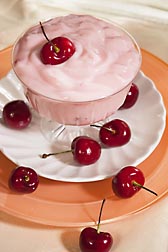Enhancing Yogurt With Healthful Fiber From Oats
|
|
Adding about one-quarter teaspoon of a fiber-rich component of oats boosts the nutritional value of low-fat yogurt without noticeably affecting the taste or texture of this increasingly popular dairy food.
Oat fiber is of interest to foodmakers and nutritionists alike. Studies with volunteers have shown that it can lower serum cholesterol, which may help improve heart health.
Agricultural Research Service food technologist Mukti Singh, chemist Sanghoon Kim, and their colleagues experimented with adding fiber-containing oat beta-glucan to what’s known in the dairy industry as “low-fat yogurt mix.” It is made up of low-fat milk and a selection of common, safe-to-eat bacteria that ferment the milk. Best known bacteria include Lactobacillus acidophilus or various Bifidobacterium species.
|
|
Singh’s intent was to see how much fiber she could add without altering key qualities of yogurt, including texture, viscosity, color, pH, and fermentation time.
In experiments at the ARS National Center for Agricultural Utilization Research in Peoria, Illinois, Singh’s team added 0.1, 0.2, 0.3, 0.4, or 0.5 percent purified oat beta-glucan—a light, fine-textured, whitish powder—to low-fat yogurt mix and compared the results to yogurt mix with no oat fiber.
The idea of adding edible fiber to yogurt isn’t new. But in studies such as this, Singh is filling in some of the gaps in our knowledge of how fiber may affect yogurt-mix qualities that are important to foodmakers and to yogurt fans.
In the oat beta-glucan work, the team determined that up to 0.3 percent highly purified (95 percent pure) oat beta-glucan, which translates to 0.3 grams of beta-glucan per 100 grams of yogurt mix, could be added without significantly altering key yogurt qualities. But adding 0.4 percent or higher changed the yogurt’s color, contributed to unwanted hardening, and slowed fermentation.
The 0.3-percent level of fortification totals out at 0.75 grams of fiber per 8-ounce serving of yogurt. Most Americans don’t get enough fiber, so even this small addition to a familiar dairy product helps.
A peer-reviewed article published in 2012 in the Journal of Food Science by Singh, Kim, and Sean X. Liu, research leader of the Functional Foods Research Unit at Peoria, documents the research.—By Marcia Wood, Agricultural Research Service Information Staff.
This research is part of Quality and Utilization of Agricultural Products, an ARS national program (#306) described at www.nps.ars.usda.gov.
Mukti Singh is in the Functional Foods Research Unit and Sanghoon Kim is in the Plant Polymer Research Unit, USDA-ARS National Center for Agricultural Utilization Research, 1815 N. University St., Peoria, IL 61604; (309) 681-6357 [Singh], (309) 681-6260 [Kim].
"Enhancing Yogurt With Healthful Fiber From Oats" was published in the March 2013 issue of Agricultural Research magazine.









